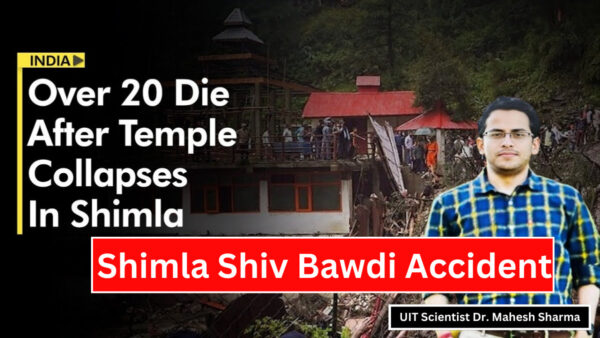Reported & Written By Kumud Sharma, Diary Times, Shimla, March 21: Cloud burst was not the cause of the devastation in Shiv Bawdi temple in Shimla, the capital of Himachal Pradesh. Scientists have attributed the water accumulated under the hill in Summerhill as the main reason for the destruction in the Shimla Shiv Bawdi Temple. This was the same water collected at the bottom of the Summerhill which used to come to Shiv Bawdi. On the day of the incident, landslides occurred due to increased water pressure due to heavy rains. On August 14 last year, 20 people were killed in a landslide at Shiv Bawdi temple.
Get The Latest News Of Himachal First On Mobile, Click Here To Join Our WhatsApp Group
Scientists from Himachal Pradesh University’s University Institute of Technology (UIT) Summerhill and Council of Scientific and Industrial Research (CSIR) Roorkee have investigated the landslide from the European Space Agency’s satellite Sentinel-1. In this, cloud burst has not been mentioned as the main reason for the tragedy that took place in Shiv Bawdi temple. Investigation revealed that there was a reservoir of groundwater beneath the mountain in Summerhill, which was providing water to the Shiv Bawdi. This water increased due to the rains that had been happening for a long time, due to which the pressure in the hill increased.
We’re now on WhatsApp –Click to join
such investigation was conducted –
The rocks could not withstand the pressure of water and on August 14, at 7 am, a landslide occurred in the upper part of Summerhill-Baluganj. For research, scientists first examined the soil samples of Summerhill and also studied the direction of the landslide through a drone. Scientists also examined CCTV footage of the Indian Institute of Advanced Study. Estimated rainfall data. After this, geothermal images of the area were studied from Sentinel-1. UIT scientist Mahesh Sharma said that this landslide is different from cloudburst landslides. CSIR Roorkee scientists Suvam Das, Anindya Pain, Shantanu Sarkar, Devi Prasanna Kanungo were included in the investigation team. Scientists revealed that the possibility of another landslide in this Summerhill area cannot be ruled out.
Read More: HPU Shimla: UG Final Year Examinations Will Start From March 28, Final Datesheet Released.
when and how much rain did it rain –
Summerhill received 60 mm of rainfall on 13 August and 160 mm of rainfall on 14 August. Due to so much rain, debris along with water in Shiva Bawdi started flowing towards the temple at a speed of 34 kilometers per hour. There were 20 people present in the temple at that time. At 7:20 am, the debris moved forward, destroying two roads and a railway track and destroying the temple.
Continuing the achievement of the journey of effectiveness and credibility of more than 10 years in the career of journalism, as a woman journalist, I am Serving as the founder, promoter and editor of DiaryTimes with the trust and support of all. My credible coverage may not have given a big shape to the numbers, but my journey presents articles that make you aware of the exact and meaningful situations of Himachal’s politics, ground issues related to the public, business, tourism and the difficult geographical conditions of the state and financial awareness. DiaryTimes, full of the experience of my precise editorial expertise, is awakening the flame of credible journalism among all of you, so that the eternal flame of meaningful change can be lit in the life of the people of the state and the atrocities being committed against the people can be brought to the fore, I am motivated for that. If even a small change comes with the power of my journalism and the whole world becomes a witness to that issues, then I will consider myself fortunate.
